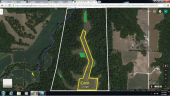




Rez Zircon wrote:See this wretched looking tree? it's been neglected for decades and mauled by bears. (It appears to be own-root, not grafted. It doesn't sucker.)
All I've done is chop out the deadwood I could reach from the ground. And this year we had a lot of spring rain. Look what it did -- these are all on one branch (out of reach without a ladder, so I didn't do anything with 'em):
They're not the best apples, but goes to show what a death-warmed-over tree is still capable of.
One up the way that two years ago looked totally dead from being covered with vines -- took two years to recover but this year has about a dozen apples on it and is looking much better.
Strong belief triggers the mind to find the way




David Gould wrote:
Over this side of the pond the orchard farmers try to limit the number of apples on each tree ... too many apples will never produce the optimum fruit . I've seen one or two actually knocking blossom off with long bamboo poles if a large percentage has been pollenated & started to turn brown . Where I live a late May frost or strong winds solve the problem for me ......I 'm lucky to get a decent crop most years .
yet another victim of Obsessive Weeding Disorder




Rez Zircon wrote:
David Gould wrote:
Over this side of the pond the orchard farmers try to limit the number of apples on each tree ... too many apples will never produce the optimum fruit . I've seen one or two actually knocking blossom off with long bamboo poles if a large percentage has been pollenated & started to turn brown . Where I live a late May frost or strong winds solve the problem for me ......I 'm lucky to get a decent crop most years .
Thought about that, but didn't realise it had set so many until they were this big (previously it's had ones and twos and I stopped paying attention) and they don't get any bigger regardless -- it's about one tree worth total, but ALL on one branch; other branches had one or none. I think I'll be keeping that branch on any future trimmings...!!
Strong belief triggers the mind to find the way




David Gould wrote: If the tree is not producing on the other large branches next year , learn how to graft fresh cut very early spring apple scions on about 24 - 18 inches long , low down in the trunk
yet another victim of Obsessive Weeding Disorder








David Maxwell wrote:>whoever previously cut away major deadwood didn't seal that either, so the core is punky.
Actually, this is false. Painting cut ends has no beneficial effect - the tree seals the cut itself. And the rot is not the result of any failure of anybody in the past.
yet another victim of Obsessive Weeding Disorder








David Maxwell wrote:You are absolutely correct that wood flat across, where water will accumulate leads to invasion by fungi, and rot of the wood. But 1) painting it with any form of goo does not prevent this
yet another victim of Obsessive Weeding Disorder
 1
1




david fischer wrote:In pruning a tree, less is always best.
"People may doubt what you say, but they will believe what you do."
 1
1




Todd Parr wrote:
david fischer wrote:In pruning a tree, less is always best.
I used to believe this, but I have seen too many trees in horrible condition that were brought back to good health by severe pruning to believe it anymore. Very heavy pruning can also make really spindly specimens thick and healthy again. Take pollarding as an example. Pollarding is really just pruning everything off the tree except a tall stump. Coppicing is just cutting the tree down almost at the ground. From what I have read and been told, you can keep a tree from ever dying of old age by pollarding or coppicing it.
yet another victim of Obsessive Weeding Disorder

|
I remember because of the snow. Do you remember tiny ad?
The new purple deck of permaculture playing cards
https://www.kickstarter.com/projects/paulwheaton/garden-cards
|






